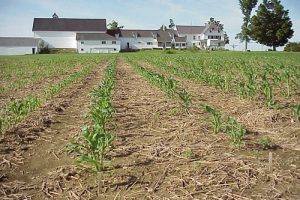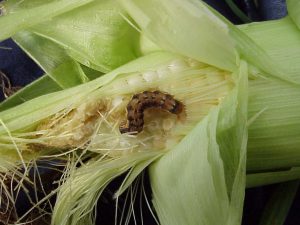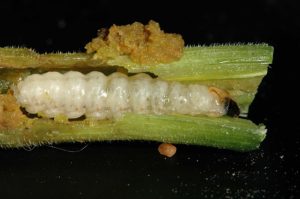Sweet Corn IPM Newsletter No. 5 – July 22, 2022
 Sweet Corn IPM Newsletter No. 5 – July 22, 2022
Sweet Corn IPM Newsletter No. 5 – July 22, 2022
PEST ACTIVITY REMAINS LOW…. FOR NOW
Pest Numbers May Rise with Any Storms from the South
Mark your calendars! Highmoor Summer Tour – Wednesday, July 27, 2022
1:30pm – Maine Pomological Society Meetings and Farm Tour ($10)
5pm – BBQ Supper ($25)
6pm – Vegetable and Small Fruit Farm Tour (free)
SITUATION
Despite a soaking rain for many early in the week, field conditions remain quite dry in any unirrigated sites. Harvest is underway in the southern end of the state, and the rest will not be far behind, as the string of hot weather hastens maturity. Insect counts remain low this week, in spite of warm nights, so few or no sprays were recommended at most locations. However, at this point in the season, the situation could change rapidly if any significant storm fronts move into Maine from the south.
European corn borer: Larval feeding injury was not over the 15% control threshold for pre-tassel corn at any of our scouting sites, although low-level feeding activity was observed in most fields. Moth activity was also low, with no sites over the 5-moth threshold for silking corn.

Corn earworm: Moth counts remain low at this time. However, with many fields now in silk growers should be ready to protect fields should fronts coming in from the south bring more earworm moths into the state. A 6-day spray interval for fresh silking corn was recommended in Cape Elizabeth, Garland, and at one Wells site. All other sites were below threshold.
Fall armyworm: Fall armyworm moths were over the three-moth threshold for silking corn in Biddeford, and one Lewiston site. Both sites were not on a spray interval for corn earworm, so a spray to protect silking corn was recommended. Larval feeding damage on leaves and tassels was found at several sites, but not over threshold. When both fall armyworm and European corn borer feeding damage are present in a field, the standard 15% feeding injury threshold may be lowered to 13%, especially under warm conditions, because the activity can become economically significant more rapidly.
Western Bean Cutworm: Moths were more widespread this week and were found in higher numbers at most locations, although we have not yet found any larval feeding damage in the field. The optimal time for controlling the larvae is late pre-tassel to tassel, when they move from the leaves and stalk into the ears.

Squash vine borer: Moths were caught at all of our trapping sites this week, with numbers ranging from 11 to 30. With the threshold of 5 moths per week, this means that all sites should be applying sprays for squash vine borer at this time. See the New England Vegetable Management Guide for control options.

Spotted wing drosophila alert: Counts of spotted wing drosophila were higher in berry fields this week with one site now over the control threshold. We expect numbers to continue to rise as more food (ripe berries) becomes available. For more information visit our SWD blog.
Highmoor Farm, the Maine Agriculture and Forest Experiment Station in Monmouth will hold a summer tour and BBQ dinner on Wednesday, July 27, from 1:30 to 7:30 p.m. For information and registration click here.
Sincerely,
David T. Handley
Vegetable and Small Fruit Specialist
Highmoor Farm UMaine Extension Diagnostic
P.O. Box 179 Research Lab, Pest Mgmt. Unit
52 U.S. Route 202 17 Godfrey Drive
Monmouth, ME 04259 Orono, ME 04473
207.933.2100 1.800.287.0279
Sweet Corn IPM Weekly Scouting Summary
| Location | CEW
Moths |
ECB
Moths |
FAW
Moths |
%Feeding
Damage |
Recommendations / Comments |
| Biddeford | 1 | 0 | 5 | 14% | One spray on silking corn for FAW |
| Bowdoinham | 1 | 0 | 2 | 4% | No spray recommended |
| Cape Elizabeth | 2 | 0 | 0 | 5% | 6-day spray interval for silking corn |
| Dayton I | 0 | 0 | 0 | 0% | No spray recommended |
| Dayton II | 0 | 1 | 0 | 2% | No spray recommended |
| Farmington | 0 | 0 | 0 | 13% | No spray recommended |
| Garland | 2 | 1 | 0 | 1% | 6-day spray interval for silking corn |
| Lewiston | 0 | 0 | 4 | 0% | One spray on silking corn for FAW |
| Lewiston II | 0 | 0 | 0 | 1% | No spray recommended |
| New Gloucester | 1 | 0 | 0 | 3% | No spray recommended |
| Oxford | 0 | 0 | 0 | 13% | No spray recommended |
| Sabattus | 0 | 1 | 0 | 4% | No spray recommended |
| Wayne | 0 | 0 | 0 | 1% | No spray recommended |
| Wells I | 0 | 1 | 1 | 1% | No spray recommended |
| Wells II | 3 | 0 | 0 | 0% | 6-day spray interval for silking corn |
CEW: Corn earworm (Only fresh silking corn should be sprayed for this insect.)
ECB: European corn borer
FAW: Fall armyworm
| European Corn Borer Thresholds
Whorl stage: 30% or more of plants scouted show injury. Pre-tassel-silk: 15% or more of plants scouted show injury. Silk: 5 or more moths caught in pheromone traps in one week. |
Corn Earworm Spray Thresholds for Pheromone Traps
| Moths caught per week | Moths caught per night | Spray interval |
| 0.0 to 1.4 | 0.0 to 0.2 | No spray |
| 1.5 to 3.5 | 0.3 to 0.5 | Spray every 6 days |
| 3.6 to 7.0 | 0.6 to 1.0 | Spray every 5 days |
| 7.1 to 91 | 1.1 to 13.0 | Spray every 4 days |
| More than 91 | More than 13 | Spray every 3 days |
Thresholds apply only to corn with exposed fresh silk. Lengthen spray intervals by
one day if maximum daily temperature is less than 80°F.
IPM Web Pages:
http://extension.umaine.edu/ipm/
http://www.pestwatch.psu.edu/sweet_corn.htm
https://ag.umass.edu/integrated-pest-management/
Where brand names or company names are used, it is for the reader’s information. No endorsement is implied nor is any discrimination intended against other products with similar ingredients. Always consult product labels for rates, application instructions and safety precautions. Users of these products assume all associated risks.
The University of Maine is an equal opportunity/affirmative action institution.
